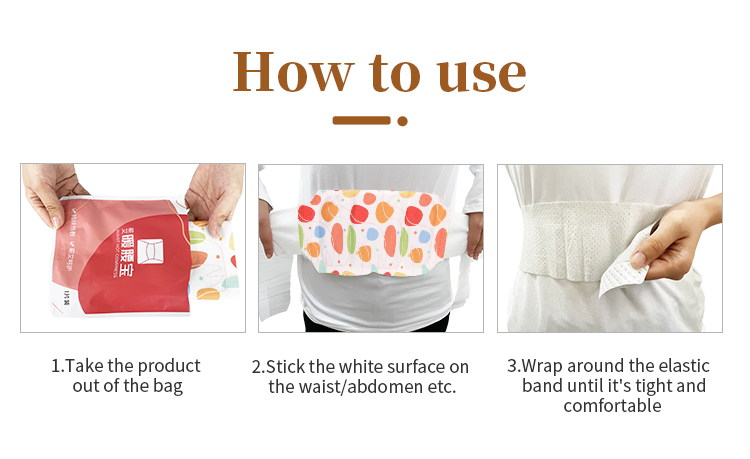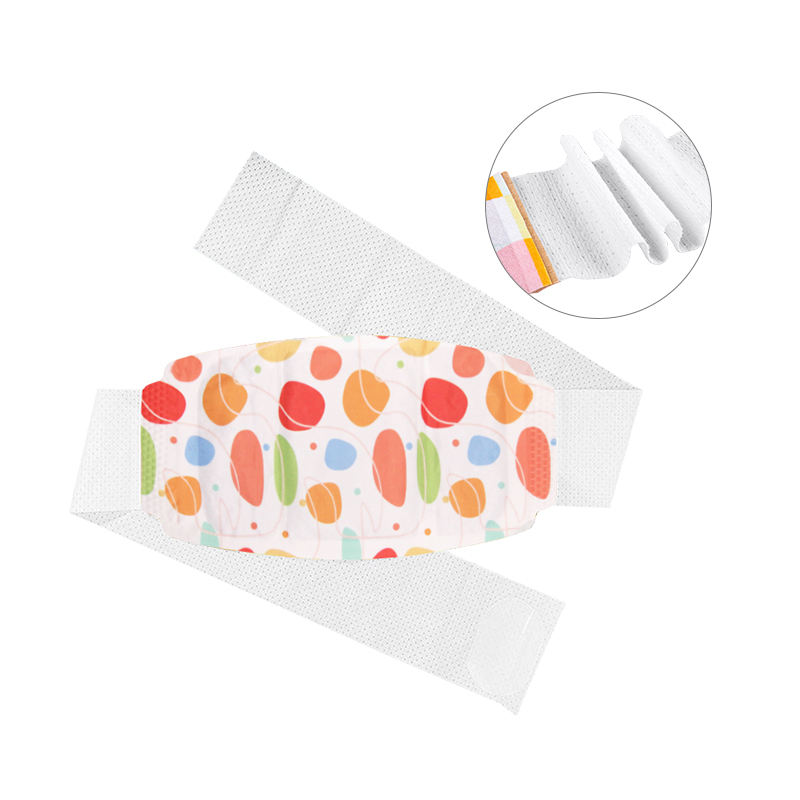Are There Eco-Friendly Options for Waist Warmer Patches?
As consumers grow more environmentally conscious, the demand for eco-friendly products has surged. Waist warmer patches, often used for pain relief and to keep the body warm in cold weather, are no exception. This article explores eco-friendly options for waist warmer patches, focusing on sustainable materials, environmentally safe production practices, and innovative solutions offered by waist warmer patches manufacturers and suppliers. Additionally, it provides insight into why choosing an eco-friendly waist warmer patch could be beneficial for both your brand and the planet.

Understanding Eco-Friendly Waist Warmer Patches
To be considered eco-friendly, waist warmer patches should ideally feature biodegradable or recyclable materials, minimal plastic packaging, and environmentally responsible production. The patch itself may incorporate natural or renewable materials, while the production process avoids harmful chemicals, ensuring less environmental impact. Choosing the right waist warmer patches OEM or private label waist warmer patches supplier who focuses on sustainable practices is essential in creating a product that aligns with eco-conscious values.
Key Factors in Eco-Friendly Waist Warmer Patches
1. Sustainable Materials
When evaluating eco-friendly waist warmer patches, it's important to consider the materials used. Many conventional patches contain synthetic fabrics and fillers that are non-biodegradable, but there are sustainable alternatives available, such as:
- Organic Cotton: Organic cotton is a renewable resource, grown without harmful pesticides, and is biodegradable. It is a comfortable and breathable option for the outer layer of waist warmer patches.
- Bamboo Fiber: Bamboo is a fast-growing plant, requiring fewer resources than cotton, and has antibacterial properties, making it a good alternative for eco-friendly waist warmer patches.
- Biodegradable Gels or Filler Material: The heat-retaining element inside the waist warmer patch is crucial, and some manufacturers use biodegradable fillers made from natural materials such as cornstarch.
By working with a waist warmer patches OEM focused on sustainability, brands can source eco-friendly materials, creating products that appeal to environmentally aware consumers.
2. Environmentally Safe Production Practices
Eco-friendly waist warmer patches are not just about the materials but also the manufacturing processes. A waist warmer patches manufacturer that adopts environmentally safe practices will implement waste-reducing systems, energy-efficient technologies, and water conservation. Some steps include:
- Reduced Water Usage: The textile and manufacturing industry is known for high water consumption, so choosing a waist warmer patches supplier that uses recycled or minimal water is an important factor.
- Low Carbon Emissions: Some waist warmer patches OEMs use renewable energy in their facilities, which reduces the carbon footprint associated with production.
- Non-Toxic Adhesives and Additives: Environmentally friendly waist warmer patches avoid the use of harmful chemicals and adhesives that can harm the environment when disposed of.
3. Recyclable or Biodegradable Packaging
Packaging is a significant environmental concern, especially with single-use products. Selecting custom waist warmer patches with biodegradable or recyclable packaging is a step toward eco-friendliness. Cardboard or recycled paper are sustainable options for packaging.
For example, a waist warmer patches supplier may offer compostable packaging or materials like recycled cardboard, reducing waste and aligning with eco-conscious branding.
4. Private Label Waist Warmer Patches with Sustainable Branding
Many brands choose private label waist warmer patches to have greater control over their brand image and sustainability initiatives. By collaborating with an eco-friendly waist warmer patches OEM, brands can produce custom patches that communicate a commitment to sustainability, appealing to customers who prioritize eco-friendly products.
5. Certifications and Standards
Certifications help verify the eco-friendliness of waist warmer patches and provide a benchmark for quality and sustainability. Look for certifications like Global Organic Textile Standard (GOTS), OEKO-TEX, or Fair Trade, which ensure that products meet specific environmental and social responsibility standards.
Benefits of Choosing Eco-Friendly Waist Warmer Patches for Your Brand
Opting for eco-friendly waist warmer patches offers a range of benefits for businesses looking to make an impact on the environment while also enhancing their market presence.
1. Appeals to Eco-Conscious Consumers
Modern consumers often prefer sustainable products, and eco-friendly waist warmer patches can help brands meet this demand. Partnering with a waist warmer patches OEM that produces sustainable patches aligns the brand with these values and makes it attractive to environmentally conscious customers.
2. Enhanced Brand Reputation
Brands that commit to eco-friendly options for waist warmer patches can boost their reputation in the market. Consumers respect brands that care about the planet, and a brand that chooses a sustainable waist warmer patches manufacturer or supplier builds customer loyalty and trust.
3. Reduced Environmental Impact
Eco-friendly waist warmer patches minimize environmental damage by reducing landfill waste, pollution, and energy consumption. Custom waist warmer patches made with biodegradable materials break down naturally over time, making them a better choice for the environment.
4. Increased Profit Potential
Eco-friendly products often command a premium price, as customers are willing to pay more for environmentally friendly options. Collaborating with an eco-conscious waist warmer patches supplier or OEM allows brands to create a unique product offering that can lead to higher profits.
Choosing the Right Eco-Friendly Waist Warmer Patches Supplier
1. Research and Transparency
It's important to work with a waist warmer patches OEM that is transparent about their materials, production process, and sustainability efforts. Look for manufacturers who provide clear information on their sourcing and production methods.
2. Customization Options for Eco-Friendly Materials
A reputable waist warmer patches manufacturer will offer customization options to use eco-friendly materials. Discuss with your supplier the availability of sustainable fabrics, fillers, and packaging.
3. Inquire About Certifications
Work with waist warmer patches suppliers who hold relevant certifications that verify their sustainability claims. Certifications offer consumers assurance that the product is genuinely eco-friendly.
4. Flexible MOQ (Minimum Order Quantity) for Eco-Friendly Options
Not all brands need large quantities, especially when testing a new eco-friendly product. Choose a waist warmer patches OEM that offers a flexible minimum order quantity, allowing you to trial eco-friendly patches before scaling up.
Examples of Eco-Friendly Waist Warmer Patches in the Market
While still an emerging market, some brands and waist warmer patches manufacturers are already offering eco-friendly alternatives. Examples include:
- Reusable Heat Patches: Some waist warmer patches are designed to be reheated and reused, reducing single-use waste.
- Compostable Heat Patches: Some custom waist warmer patches use fully biodegradable materials that can be composted after use, making disposal environmentally friendly.
Conclusion
Eco-friendly options for waist warmer patches are available and increasingly important in the market. Brands that prioritize sustainability can work with a dedicated waist warmer patches manufacturer or supplier to create custom products that meet consumer demands for environmentally safe solutions. By focusing on sustainable materials, eco-friendly production practices, and recyclable packaging, brands can enhance their reputation and reduce their environmental impact.
Related Questions and Answers
What materials are used in eco-friendly waist warmer patches?
Eco-friendly waist warmer patches use materials like organic cotton, bamboo fiber, and biodegradable fillers instead of synthetic fabrics and gels.Why should I consider working with a waist warmer patches OEM focused on sustainability?
An eco-conscious OEM can provide access to sustainable materials, energy-efficient production, and lower environmental impact, which helps align with eco-friendly branding.Can waist warmer patches be reusable?
Yes, some eco-friendly waist warmer patches are designed to be reusable, providing long-term use and reducing waste.Is biodegradable packaging available for waist warmer patches?
Many waist warmer patches suppliers offer biodegradable or recyclable packaging options to minimize waste and appeal to eco-conscious consumers.What certifications should I look for in eco-friendly waist warmer patches?
Look for certifications such as GOTS, OEKO-TEX, and Fair Trade, which indicate sustainable materials and environmentally safe production practices.






